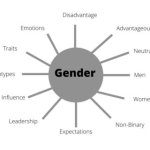In today’s increasingly digital workspace, email, chat, and instant messaging dominate how colleagues communicate. Yet, beneath this veneer of neutrality lies a persistent—and deeply problematic—bias: women’s digital communication is often misinterpreted as emotional, passive-aggressive, or “too sensitive.” This isn’t just an occasional misunderstanding; it’s a systemic issue that undermines women’s voices and damages workplace dynamics.
Despite advances in gender equality, a shocking number of female professionals report their emails or messages being dismissed or criticized for “tone” or “attitude” when, in reality, their communication is clear and professional. Why does this happen? The root cause is gendered communication bias—an unconscious tendency to interpret women’s words through a stereotypical lens that equates assertiveness with aggression and sensitivity with emotional instability.
Emails, stripped of vocal tone and body language, rely heavily on the reader’s interpretation. Here’s where bias creeps in. Studies show men and women use language differently: women tend to employ more polite forms, hedging phrases (“I think,” “perhaps”), and inclusive language (“we should consider”), while men often write more direct, declarative sentences. Ironically, these polite strategies intended to foster collaboration are sometimes read as weak or indecisive. When a woman writes “I’m concerned about the deadline,” a male reader may interpret that as whining or fearfulness, rather than a legitimate business concern.
This misreading has serious consequences. Women’s ideas may be undervalued, their feedback ignored, or worse, they may be labeled “difficult” or “overly emotional.” Meanwhile, men expressing the same points with blunt language are praised for confidence and decisiveness. This double standard perpetuates gender inequality and can stunt career growth.
Companies that fail to recognize this bias risk fostering toxic cultures. When female employees feel their communication style is constantly policed or misunderstood, they may withdraw from important discussions, self-censor, or avoid digital channels altogether. This silence not only harms their professional development but also deprives organizations of diverse perspectives critical for innovation.
What can be done to break this cycle? Awareness is the first step. Training programs on unconscious bias should include examples of gendered communication differences and encourage empathy in interpreting written messages. Managers must lead by example—modeling inclusive communication and discouraging stereotypes about “tone.”
Additionally, digital communication norms can be adapted. For example, encouraging clarity through explicit statements about intent (“I’m sharing this to highlight a concern, not to criticize”) can reduce ambiguity. Teams might also adopt feedback rituals where messages are discussed openly to clarify tone before assumptions are made.
Some forward-thinking companies are even experimenting with AI tools designed to flag potentially biased language interpretations or to suggest more neutral phrasing. While AI can’t solve human prejudice, it can support a more objective review of communication.
Ultimately, the message is clear: women are not “too emotional” online. The problem lies with those who misread their emails through a biased lens. For workplaces aiming to be truly inclusive and equitable, dismantling this gendered communication bias is not optional—it’s essential. Because when we start hearing what women say, rather than what we expect to hear, everyone wins.

Despite advances in gender equality, a shocking number of female professionals report their emails or messages being dismissed or criticized for “tone” or “attitude” when, in reality, their communication is clear and professional. Why does this happen? The root cause is gendered communication bias—an unconscious tendency to interpret women’s words through a stereotypical lens that equates assertiveness with aggression and sensitivity with emotional instability.
Emails, stripped of vocal tone and body language, rely heavily on the reader’s interpretation. Here’s where bias creeps in. Studies show men and women use language differently: women tend to employ more polite forms, hedging phrases (“I think,” “perhaps”), and inclusive language (“we should consider”), while men often write more direct, declarative sentences. Ironically, these polite strategies intended to foster collaboration are sometimes read as weak or indecisive. When a woman writes “I’m concerned about the deadline,” a male reader may interpret that as whining or fearfulness, rather than a legitimate business concern.
This misreading has serious consequences. Women’s ideas may be undervalued, their feedback ignored, or worse, they may be labeled “difficult” or “overly emotional.” Meanwhile, men expressing the same points with blunt language are praised for confidence and decisiveness. This double standard perpetuates gender inequality and can stunt career growth.
Companies that fail to recognize this bias risk fostering toxic cultures. When female employees feel their communication style is constantly policed or misunderstood, they may withdraw from important discussions, self-censor, or avoid digital channels altogether. This silence not only harms their professional development but also deprives organizations of diverse perspectives critical for innovation.
What can be done to break this cycle? Awareness is the first step. Training programs on unconscious bias should include examples of gendered communication differences and encourage empathy in interpreting written messages. Managers must lead by example—modeling inclusive communication and discouraging stereotypes about “tone.”
Additionally, digital communication norms can be adapted. For example, encouraging clarity through explicit statements about intent (“I’m sharing this to highlight a concern, not to criticize”) can reduce ambiguity. Teams might also adopt feedback rituals where messages are discussed openly to clarify tone before assumptions are made.
Some forward-thinking companies are even experimenting with AI tools designed to flag potentially biased language interpretations or to suggest more neutral phrasing. While AI can’t solve human prejudice, it can support a more objective review of communication.
Ultimately, the message is clear: women are not “too emotional” online. The problem lies with those who misread their emails through a biased lens. For workplaces aiming to be truly inclusive and equitable, dismantling this gendered communication bias is not optional—it’s essential. Because when we start hearing what women say, rather than what we expect to hear, everyone wins.

